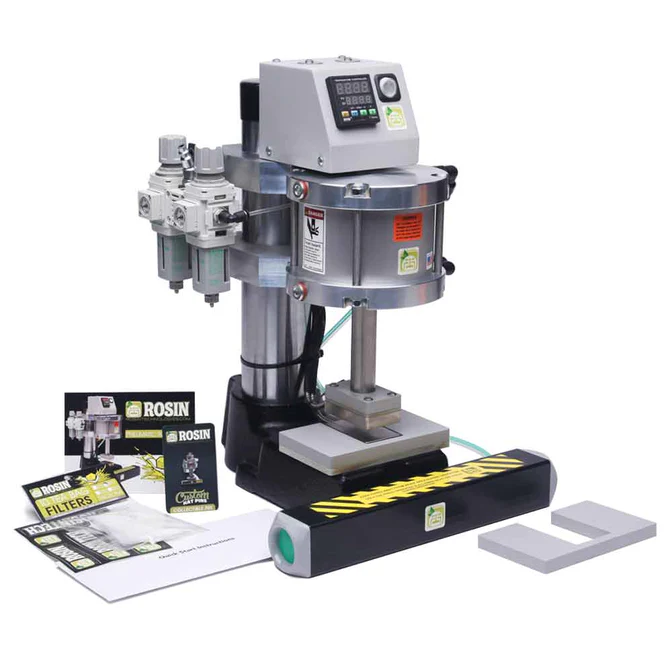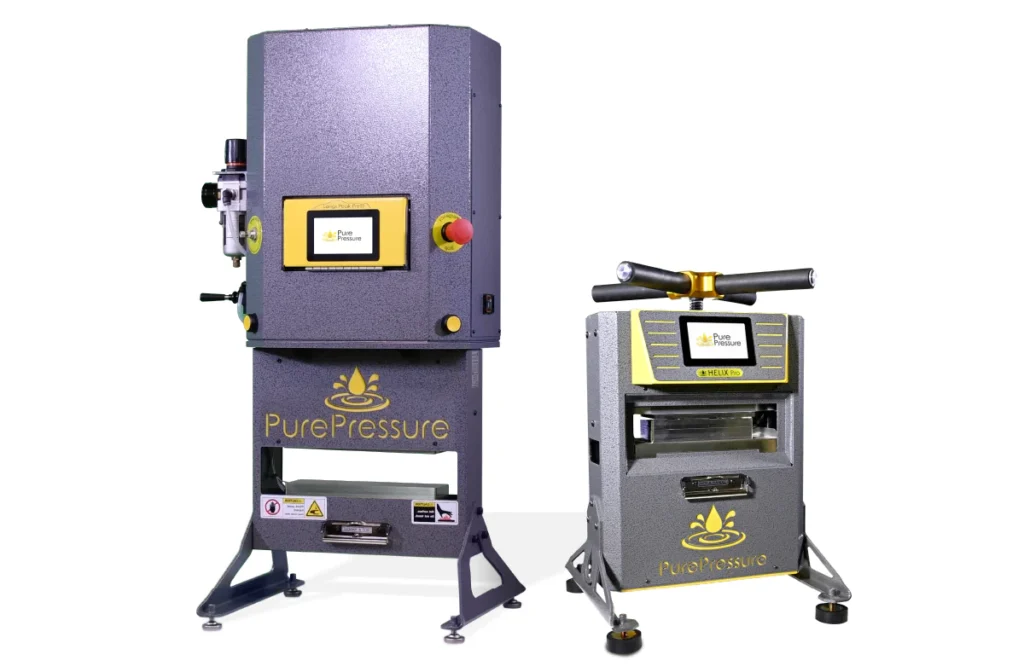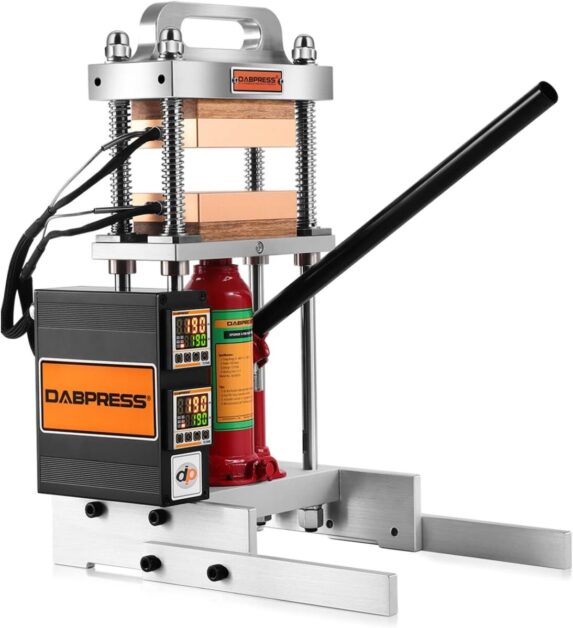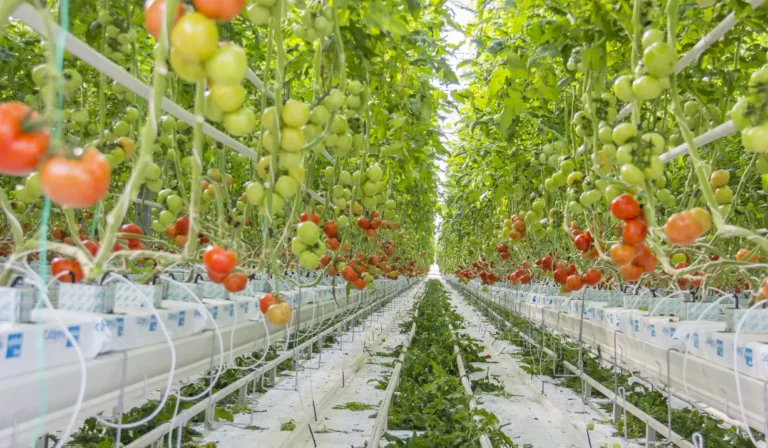Best Rosin Press: A Review of the Top Products for Rosin Extraction
Table of Contents
Top Rosin Press Brands in the Market
There are several top rosain press brands in the market that are known for their quality and durability. One of the leading brands is NugSmasher, which offers a range of high-quality presses for both personal and commercial use. NugSmasher presses are known for their heavy-duty construction, precise temperature control, and ability to extract high yields of rosin. Another top brand is Rosin Tech Products, which is recognized for its innovative designs and state-of-the-art technology. Rosin Tech presses are built to last and offer features such as digital controls, dual heated plates, and adjustable pressure settings, making them a popular choice among rosin enthusiasts. Additionally, Triminator is a brand that has gained a reputation for its high-performance presses that are designed to maximize efficiency and yield. Triminator presses are known for their large pressing areas, precise pressure control, and user-friendly interface.
When choosing a rosin press, it is important to consider factors such as the size and type of material you plan to press, the desired yield and quality of the rosin, and your budget. Different types of rosin presses are available in the market, including manual, hydraulic, and pneumatic presses. Manual presses are often more affordable and suitable for personal use, while hydraulic and pneumatic presses offer greater pressure control and are preferred by commercial users. Key features to look for in a rosin press include even heat distribution, adjustable temperature and pressure settings, and sturdy construction. Ultimately, selecting the right rosin press brand and model will depend on your specific needs and preferences.

Factors to Consider When Choosing a Rosin Press
When it comes to choosing a rosin press, there are several key factors that should be taken into consideration to ensure you make the right choice for your needs. The first factor to consider is the pressing capacity of the machine. This refers to the amount of pressure the press can generate, which directly affects the yield and quality of your rosin. It’s important to choose a press with a capacity that aligns with your production goals.
Another important factor to consider is the pressing size of the machine. This refers to the size of the plates where the extraction process takes place. The size of these plates will determine how much material you can press at once, and therefore affects the overall efficiency of your extraction process. Additionally, you’ll want to consider the temperature control capabilities of the rosin press. The ability to accurately control the temperature during the extraction process is crucial for preserving the terpenes and cannabinoids in your material, resulting in a higher quality rosin.
Different Types of Rosin Presses Available
Rosin presses have become increasingly popular in recent years, providing home gardeners and professional cultivators with an efficient and effective method for extracting high-quality rosin from cannabis and other plant materials. There are various types of rosin presses available on the market, each offering unique features and capabilities to suit different extraction needs.
One of the most common types of rosin presses is the manual press. Manual presses utilize the operator’s physical force to exert pressure on the plant material, resulting in the extraction of rosin. These presses are often compact in size and affordable, making them an ideal choice for beginners or those with a smaller budget. However, it is important to note that manual presses require more effort and time compared to other types of rosin presses.
On the other end of the spectrum, we have hydraulic rosin presses. These advanced machines utilize hydraulic pressure to extract rosin, eliminating the need for manual force. Hydraulic presses are known for their powerful extraction capabilities, allowing for higher yields and better quality rosin. Additionally, they often feature digital controls and adjustable settings, providing users with greater precision and control over the extraction process. However, hydraulic presses tend to be larger, more expensive, and require more space for operation.
It is worth mentioning that there are other types of rosin presses available, such as pneumatic presses and electric presses. Pneumatic presses use compressed air to generate the necessary pressure for extraction, offering a balance between manual and hydraulic presses. Electric presses, on the other hand, rely on electricity to power the extraction process, providing a more automated and convenient experience.
When selecting a rosin press, it is crucial to consider factors such as the desired yield, quality, and budget. It is also important to research and compare different brands and models, ensuring that the chosen press aligns with specific extraction needs. Whether opting for a manual, hydraulic, pneumatic, or electric press, each type of rosin press offers its own advantages and considerations to help achieve the desired results in rosin extraction.
| Type of Rosin Press | Description |
|---|---|
| Manual Rosin Press | Operated manually using a hand crank or lever. Requires physical effort to apply pressure and extract rosin. Generally more affordable but slower and less efficient. |
| Pneumatic Rosin Press | Operates using compressed air to apply pressure. Offers consistent pressure control and higher yield compared to manual presses. Requires an air compressor. |
| Hydraulic Rosin Press | Utilizes hydraulic pressure to extract rosin. Offers high pressure capability, precise control, and high yields. Often more expensive but efficient for commercial operations. |
| Electric Rosin Press | Powered by electricity, these presses automate the pressing process. They offer consistent pressure and temperature control, making them suitable for large-scale production. |
| DIY Rosin Press | Homemade rosin presses constructed from parts or kits. Often less expensive but may lack consistency and durability compared to commercial models. Requires technical skills to assemble. |
Key Features to Look for in a Rosin Press
When considering a rosin press, there are several key features to look for to ensure you are making the right choice for your needs. First and foremost, heat distribution is crucial for achieving optimal results. Look for a press that offers even and precise heat distribution across the platens. This will ensure that your material is heated uniformly, resulting in a higher yield and better quality rosin.
Another important feature to consider is pressure control. The ability to adjust the pressure applied during the pressing process is essential for obtaining consistent and desirable results. Look for a rosin press that allows you to easily adjust the pressure settings, whether it’s through a manual control or a digital interface. This will give you the flexibility to experiment with different pressure levels and find the perfect balance for extracting the most potent and flavorful rosin from your plant material.
Additionally, a sturdy build and durable construction are important factors to consider when choosing a rosin press. Look for a press that is made from high-quality materials, such as stainless steel or aluminum, to ensure its longevity and durability. This will not only save you money in the long run but also give you peace of mind knowing that your press can withstand the rigors of regular use.
In conclusion, when looking for a rosin press, it’s important to prioritize features such as heat distribution, pressure control, and durability. By investing in a press that offers these key features, you can enjoy consistent and high-quality rosin extraction for years to come.
Pros and Cons of Using a Rosin Press
Pros of Using a Rosin Press
One of the key advantages of using a rosin press is its simplicity and ease of use. Unlike other extraction methods, such as butane hash oil (BHO) extraction, rosin pressing does not require any additional solvents or chemicals. It utilizes heat and pressure to extract the desired compounds from the plant material, making it a safer and more natural option for extracting concentrates. Moreover, the process can be easily mastered by beginners, allowing them to create high-quality concentrates without extensive knowledge or experience.
Another benefit of using a rosin press is the ability to achieve precise temperature and pressure control. This ensures that the desired compounds are extracted efficiently without causing any thermal degradation or loss of terpenes. With advanced rosin press models, users have the flexibility to adjust and fine-tune these parameters, allowing for customization based on the specific strain or desired end product. This level of control ultimately translates into a superior quality extract, with enhanced flavor and potency.
Step-by-Step Guide to Using a Rosin Press for Extraction
To successfully extract rosin using a rosin press, follow these step-by-step instructions. First, ensure that your rosin press is set up and ready for use. Connect it to a power source and make sure all the necessary components are in place. Next, prepare your material for extraction. Whether you’re using flower or hash, be sure to grind it to a consistent texture for optimal results. Take care not to over-grind, as this can increase the chances of plant material contaminating the rosin.
Once your material is prepared, place it between two sheets of parchment paper. It’s crucial to use parchment paper instead of wax paper, as the latter can melt and ruin your press. For added protection, you can also use a filter bag to prevent any plant material from getting into the rosin. Gently place the parchment paper with your material onto the heated plates of the rosin press, ensuring that the material is evenly spread. It’s important to note that the ideal temperature for extraction can vary depending on the material being used, but a general range is between 180°F and 220°F.
After the material is placed on the plates, apply pressure by lowering the top plate of the rosin press. The amount of pressure applied will depend on factors such as the type of material and the desired yield. It’s recommended to start with a lower pressure and gradually increase it until the desired results are achieved. Allow the press to apply consistent pressure for a specified amount of time, typically between 30 seconds and 3 minutes. The longer the extraction period, the more yield you can expect.
Once the extraction time is complete, carefully lift the top plate to release the pressure. Remove the parchment paper containing the rosin and carefully collect the extracted rosin with a dabber or rosin collection tool. Be sure to handle the rosin with clean hands or gloves to prevent contamination. It’s advisable to let the rosin cool before storing or using it.
As with any extraction method, finding the optimal settings and techniques may require some trial and error. Don’t be afraid to experiment with different temperatures, pressures, and extraction times to achieve the desired quality and yield. This step-by-step guide is a starting point to help you get acquainted with the process, but continuous learning and refinement are key to mastering the art of rosin extraction.

Tips for Maximizing Yield and Quality with a Rosin Press
When using a rosin press, there are several tips that can help you maximize both the yield and quality of your extractions. One important tip is to start with high-quality starting material. The quality of your starting material will directly impact the final product, so it’s crucial to choose strains that are known for producing high terpene and cannabinoid content. Additionally, make sure your starting material is properly cured and dried before pressing to avoid any moisture-related issues.
Another important tip is to dial in the right temperature and pressure settings for your specific material. Different strains and even different batches of the same strain may require slightly different settings to achieve optimal results. Experiment with different temperature and pressure combinations to find the sweet spot that yields the best results for your material. Keep in mind that lower temperatures tend to preserve more of the terpenes and flavors, while higher temperatures may yield more cannabinoids.
Common Mistakes to Avoid When Using a Rosin Press
One common mistake to avoid when using a rosin press is applying too much pressure. While it may seem intuitive to exert maximum force in order to extract the most rosin possible, excessive pressure can actually have a negative impact on both yield and quality. When too much pressure is applied, it can cause the plant material to be compressed too tightly, resulting in a decrease in overall rosin production. Additionally, excessive pressure can lead to higher levels of plant material contaminants being released into the rosin, compromising its purity and taste. It is important to find the right balance of pressure to achieve optimal results.
Another mistake to avoid is using improper temperature settings. The temperature at which rosin is extracted plays a crucial role in determining its consistency, potency, and flavor profile. Setting the temperature too high can cause the rosin to become overly runny, making it difficult to collect and handle. On the other hand, setting the temperature too low may result in a lower yield and a less flavorful end product. It is important to carefully consider the specific strain being used and its ideal temperature range for extraction. Proper temperature control is key to obtaining the desired consistency and preserving the integrity of the rosin’s terpene profile.
| Mistake | Explanation |
|---|---|
| Excessive Heat/Pressure | Applying too much heat or pressure can degrade the quality of the rosin and damage the press. |
| Incorrect Temperature Settings | Not setting the temperature accurately can lead to poor yields or burnt material. |
| Using Low-Quality Material | Using low-quality starting material can result in lower yields and inferior rosin quality. |
| Unevenly Distributed Pressure | Uneven pressure distribution can lead to inconsistent yields and quality across the extraction. |
| Overloading the Press | Putting too much material in the press can result in uneven extraction and lower-quality rosin. |
| Inadequate Pre-Pressing | Failing to pre-press material properly can lead to inefficient extraction and lower yields. |
| Ignoring Filter Bag Quality | Using subpar filter bags can result in contamination of the rosin and affect its quality. |
| Neglecting to Clean the Press | Not cleaning the press regularly can lead to buildup, affecting performance and hygiene. |
| Improper Cooling and Storage | Failing to cool and store rosin properly can lead to degradation of quality and potency over time. |
| Lack of Patience and Precision | Rushing the process or being imprecise can result in wasted material and lower-quality rosin. |
Maintenance and Cleaning of a Rosin Press
Regular maintenance and proper cleaning of a rosin press are crucial for ensuring its longevity and optimum performance. Neglecting these tasks can lead to a buildup of residue, decreased efficiency, and potentially affect the quality of your rosin extractions. Therefore, it is essential to incorporate cleaning and maintenance routines into your rosin press usage.
To maintain your rosin press, start by turning off and unplugging the machine. Allow it to cool down completely before proceeding with any cleaning. Begin by wiping down the exterior surfaces using a soft, lint-free cloth to remove any dust or debris. Pay close attention to the heating plates, as they can accumulate residue over time. Gently wipe them with a cloth dampened with isopropyl alcohol, ensuring not to apply excessive pressure that could damage the plates. For tough grime or residue, a soft-bristled brush can be used to gently scrub the surface.
Comparison of Manual vs. Hydraulic Rosin Presses
Manual and hydraulic rosin presses are two popular options available for extracting rosin from plant material. Each type has its own set of advantages and considerations to keep in mind when choosing the right press for your needs.
Manual rosin presses are often favored by hobbyists and small-scale producers due to their affordability and simplicity. These presses are typically operated by using a hand crank or lever to apply pressure to the plant material. While manual presses may require more physical effort and time compared to their hydraulic counterparts, they offer control over the extraction process and are more portable.
On the other hand, hydraulic rosin presses are known for their power and efficiency. These presses use hydraulic pressure, typically generated by a motor or hydraulic pump, to extract rosin from the plant material. Hydraulic presses can exert much higher pressure compared to manual presses, resulting in greater yields and faster extraction times. However, hydraulic presses are usually more expensive and may require professional setup and maintenance.
When deciding between a manual and hydraulic rosin press, it is crucial to consider factors such as the scale of production, budget, and personal preferences. Whether you prioritize control and portability or efficiency and power, understanding the key differences between the two types will help you make an informed decision for your rosin extraction needs.

Exploring DIY Options for Rosin Extraction
When it comes to rosin extraction, many gardening enthusiasts want to explore the DIY options available. DIY rosin extraction allows individuals to have complete control over the process and the quality of the final product. One of the most popular DIY options is the hair straightener method. This method involves using a hair straightener, parchment paper, and heat-resistant gloves to press buds, trim, or hash into rosin. While this method may be affordable and easily accessible, it does have its limitations. The hair straightener method is not suitable for large-scale production, as it can only press small amounts of material at a time. Additionally, it may require some trial and error to achieve the desired temperature and pressure, resulting in inconsistent yields and quality. Despite these drawbacks, the hair straightener method can be a great starting point for beginners or those looking to experiment with rosin extraction in small quantities.
Understanding the Science Behind Rosin Extraction
Rosin extraction is a fascinating process that utilizes heat and pressure to extract essential oils from plant material. The science behind rosin extraction lies in the delicate balance between temperature and pressure, which allows for the separation of desirable compounds from the plant matter.
When heat is applied to the plant material, the trichomes containing the desired oils melt and become more viscous. This allows for the oils to be easily separated from the rest of the plant material. The application of pressure then forces the oils to ooze out, while leaving behind any unwanted impurities.
The key to successful rosin extraction lies in finding the optimal temperature and pressure for a specific type of plant material. Different plants may require different heat and pressure levels to achieve the desired results. Additionally, factors such as humidity, moisture content, and the quality of the starting material can also impact the extraction process. Therefore, it is crucial to experiment and find the perfect combination of heat and pressure for each unique strain of plant material. So, how do we determine the ideal conditions for rosin extraction? Stay tuned to find out.
Exploring the Future of Rosin Press Technology
As the demand for high-quality rosin continues to grow, so does the need for improved rosin press technology. Manufacturers are constantly researching and developing new innovations to meet the evolving needs of the market.
One area of focus for the future of rosin press technology is automation. Many manufacturers are working on developing fully automated rosin presses that can perform various functions without the need for manual intervention. These presses would have built-in sensors and advanced control systems to monitor and adjust parameters such as temperature and pressure automatically. This would not only improve the efficiency and consistency of the extraction process but also make it easier for users to operate the presses with minimal effort.
Another aspect being explored is the integration of smart technology into rosin presses. Companies are looking into incorporating features such as Bluetooth connectivity, smartphone apps, and touchscreen interfaces to provide users with more control and convenience. With these advancements, users would be able to monitor and control their presses remotely, access real-time data and analytics, and even receive notifications and alerts. This integration of technology would not only enhance the overall user experience but also enable users to optimize their extraction techniques for better results.
What are some emerging technologies in the field of rosin press technology?
While the article has touched on the current state of rosin press technology, emerging technologies include automated rosin presses with advanced temperature and pressure control systems, as well as innovative solventless extraction methods.
Can a rosin press be used for commercial production?
Yes, many top rosin press brands offer commercial-grade models specifically designed for high-volume production. These presses often have larger plates and higher pressure capacities to accommodate larger batches.
Are there any safety precautions to consider when using a rosin press?
Absolutely. It is important to follow all safety instructions provided by the manufacturer, including wearing protective eyewear and gloves, using proper ventilation, and being aware of the potential risks associated with high temperatures and pressure.
Can a rosin press be used for pressing other materials besides cannabis?
Yes, while rosin extraction is commonly associated with cannabis, rosin presses can also be used to extract essential oils from other botanicals, such as lavender or mint.
Is it possible to control the consistency of the rosin extracted using a rosin press?
Yes, by adjusting factors such as temperature, pressure, and duration of the press, it is possible to influence the consistency of the rosin extracted. Experimenting with different settings can help achieve desired consistencies, such as shatter or wax.
What is the expected lifespan of a rosin press?
The lifespan of a rosin press can vary depending on the quality of the press and how well it is maintained. However, with proper care and maintenance, a high-quality rosin press can last for several years.
Can I use a rosin press at home without any professional experience?
Yes, many rosin presses are designed with user-friendly interfaces and step-by-step instructions, making them accessible to beginners. However, it is still important to thoroughly read the user manual and understand the proper techniques for safe operation.
Can I use a rosin press to extract rosin from pre-pressed material?
Yes, while it is more common to use a rosin press to extract rosin from fresh material, it is possible to use a rosin press on pre-pressed material. However, the yield and quality of the rosin may vary compared to fresh material.
Can a rosin press be used for both personal and commercial purposes?
Yes, many rosin presses are suitable for both personal and commercial use. However, it is important to consider the specific needs and requirements of your intended use, such as batch size and production volume, when choosing a rosin press.
Are there any environmental benefits to using a rosin press?
Yes, rosin extraction is a solventless extraction method, which means it does not require the use of harmful chemicals or solvents. This makes it a more environmentally friendly option compared to other extraction methods that rely on solvents.

Ankit Garg is a seasoned writer at South El Monte Hydroponics, blending his passion for agriculture with a penchant for storytelling. With a degree in Agricultural Sciences from a prestigious institution, Ankit’s expertise lies in hydroponics, sustainable farming, and innovative cultivation techniques. His keen interest in exploring the intersection of technology and agriculture has led him to delve deep into the realm of hydroponic farming, where he thrives in uncovering the latest advancements and sharing insights through his engaging prose. Ankit’s dedication to promoting eco-friendly and efficient farming practices through his writing has earned him recognition within the agricultural community and beyond.







